Analysis of Security and Privacy within Healthcare System Issues
VerifiedAdded on 2022/12/03
|5
|842
|383
Homework Assignment
AI Summary
This assignment delves into the crucial aspects of security and privacy within the healthcare system. It addresses the significant issue of patient information disclosure, outlining major causes of data breaches such as malicious attacks, human error, system faults, misuse of authority, and hacking. The solution proposes preventive measures including risk assessments, HIPAA education for healthcare staff, continuous system monitoring, data encryption, sub-network creation, and re-evaluation of service level agreements. Furthermore, the assignment identifies protected health information data elements, including names, identifiers, dates, and medical record details, and explains the importance of these data types in providing healthcare services like treatment and diagnosis. The document references relevant research to support its analysis.
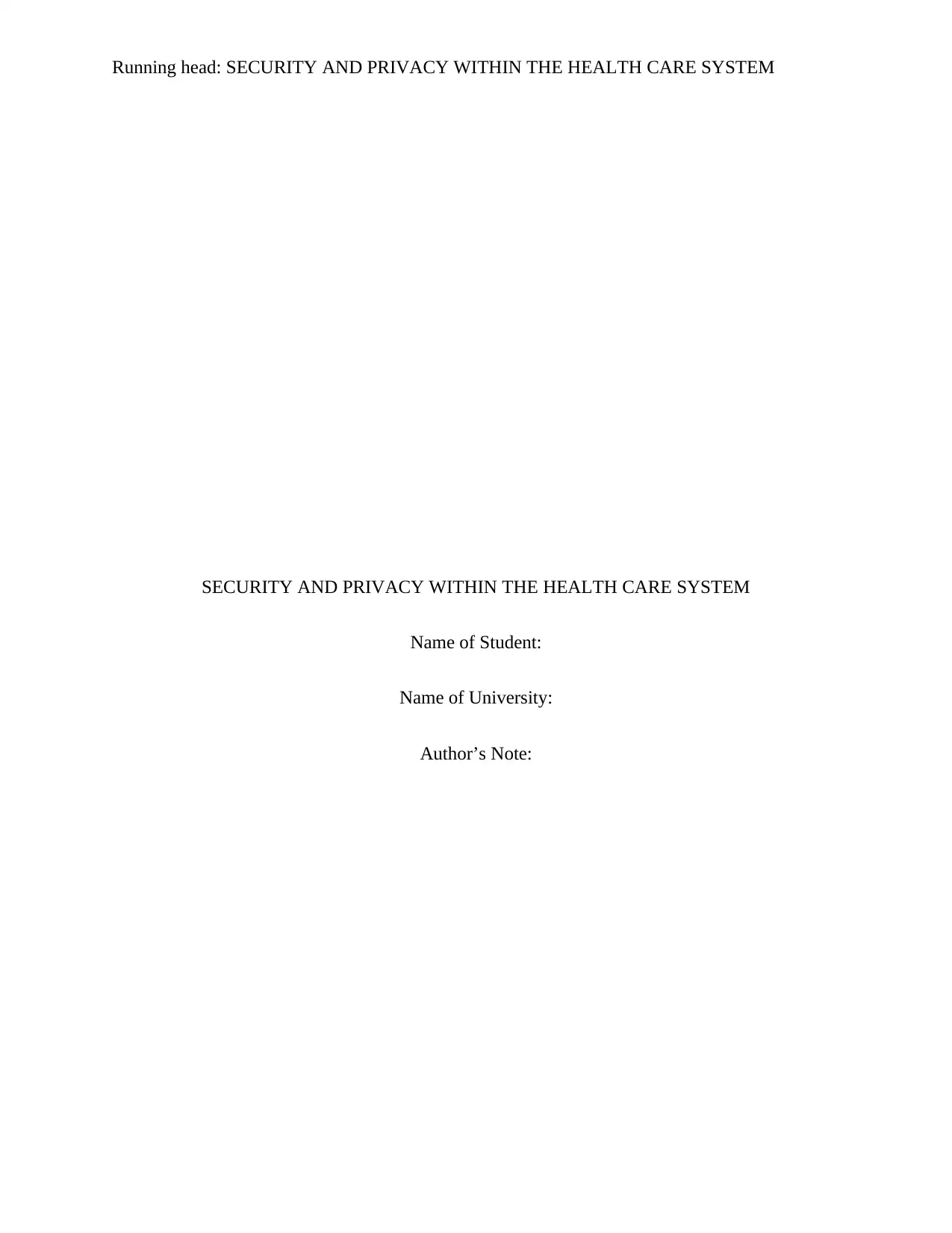
Running head: SECURITY AND PRIVACY WITHIN THE HEALTH CARE SYSTEM
SECURITY AND PRIVACY WITHIN THE HEALTH CARE SYSTEM
Name of Student:
Name of University:
Author’s Note:
SECURITY AND PRIVACY WITHIN THE HEALTH CARE SYSTEM
Name of Student:
Name of University:
Author’s Note:
Paraphrase This Document
Need a fresh take? Get an instant paraphrase of this document with our AI Paraphraser
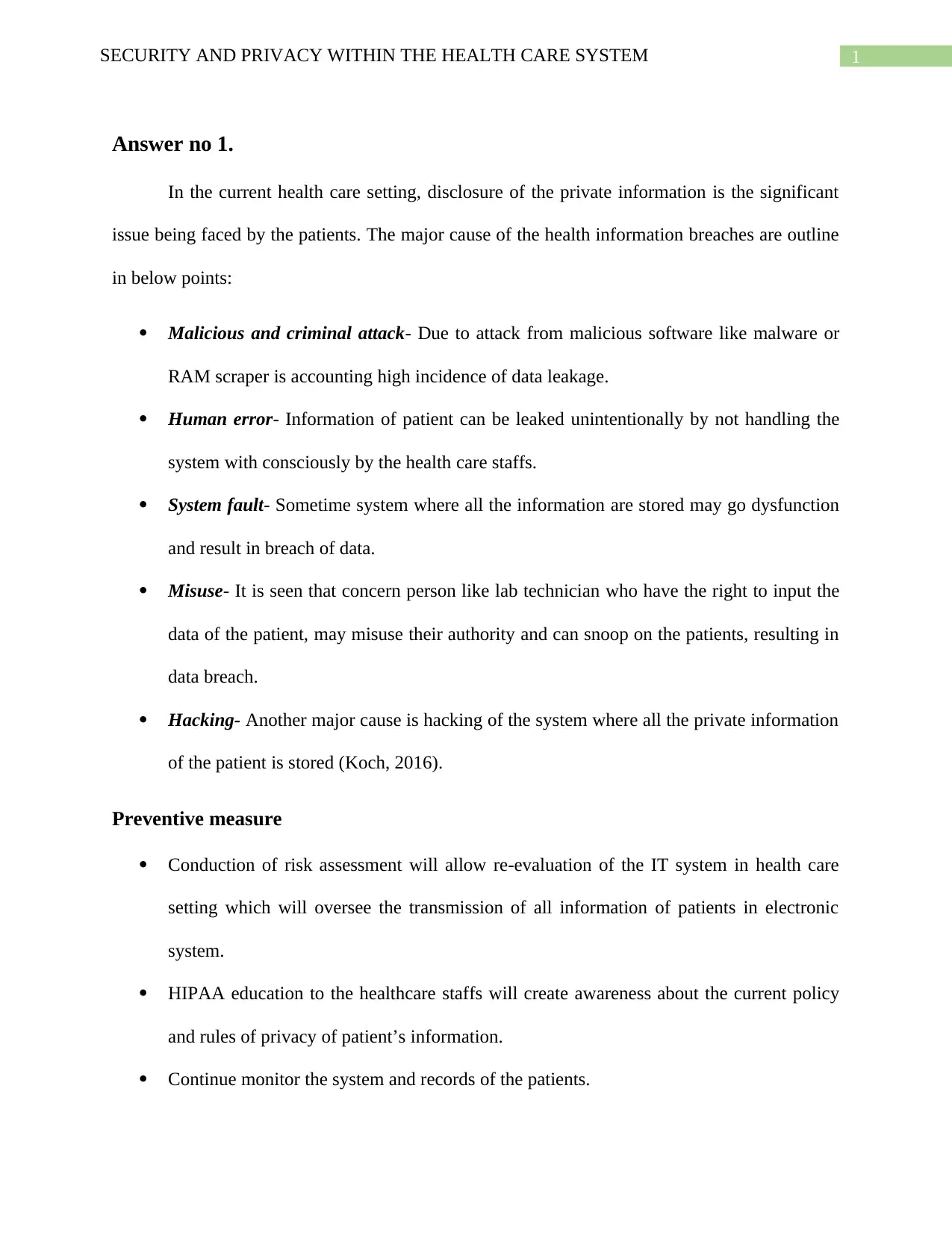
1SECURITY AND PRIVACY WITHIN THE HEALTH CARE SYSTEM
Answer no 1.
In the current health care setting, disclosure of the private information is the significant
issue being faced by the patients. The major cause of the health information breaches are outline
in below points:
Malicious and criminal attack- Due to attack from malicious software like malware or
RAM scraper is accounting high incidence of data leakage.
Human error- Information of patient can be leaked unintentionally by not handling the
system with consciously by the health care staffs.
System fault- Sometime system where all the information are stored may go dysfunction
and result in breach of data.
Misuse- It is seen that concern person like lab technician who have the right to input the
data of the patient, may misuse their authority and can snoop on the patients, resulting in
data breach.
Hacking- Another major cause is hacking of the system where all the private information
of the patient is stored (Koch, 2016).
Preventive measure
Conduction of risk assessment will allow re-evaluation of the IT system in health care
setting which will oversee the transmission of all information of patients in electronic
system.
HIPAA education to the healthcare staffs will create awareness about the current policy
and rules of privacy of patient’s information.
Continue monitor the system and records of the patients.
Answer no 1.
In the current health care setting, disclosure of the private information is the significant
issue being faced by the patients. The major cause of the health information breaches are outline
in below points:
Malicious and criminal attack- Due to attack from malicious software like malware or
RAM scraper is accounting high incidence of data leakage.
Human error- Information of patient can be leaked unintentionally by not handling the
system with consciously by the health care staffs.
System fault- Sometime system where all the information are stored may go dysfunction
and result in breach of data.
Misuse- It is seen that concern person like lab technician who have the right to input the
data of the patient, may misuse their authority and can snoop on the patients, resulting in
data breach.
Hacking- Another major cause is hacking of the system where all the private information
of the patient is stored (Koch, 2016).
Preventive measure
Conduction of risk assessment will allow re-evaluation of the IT system in health care
setting which will oversee the transmission of all information of patients in electronic
system.
HIPAA education to the healthcare staffs will create awareness about the current policy
and rules of privacy of patient’s information.
Continue monitor the system and records of the patients.
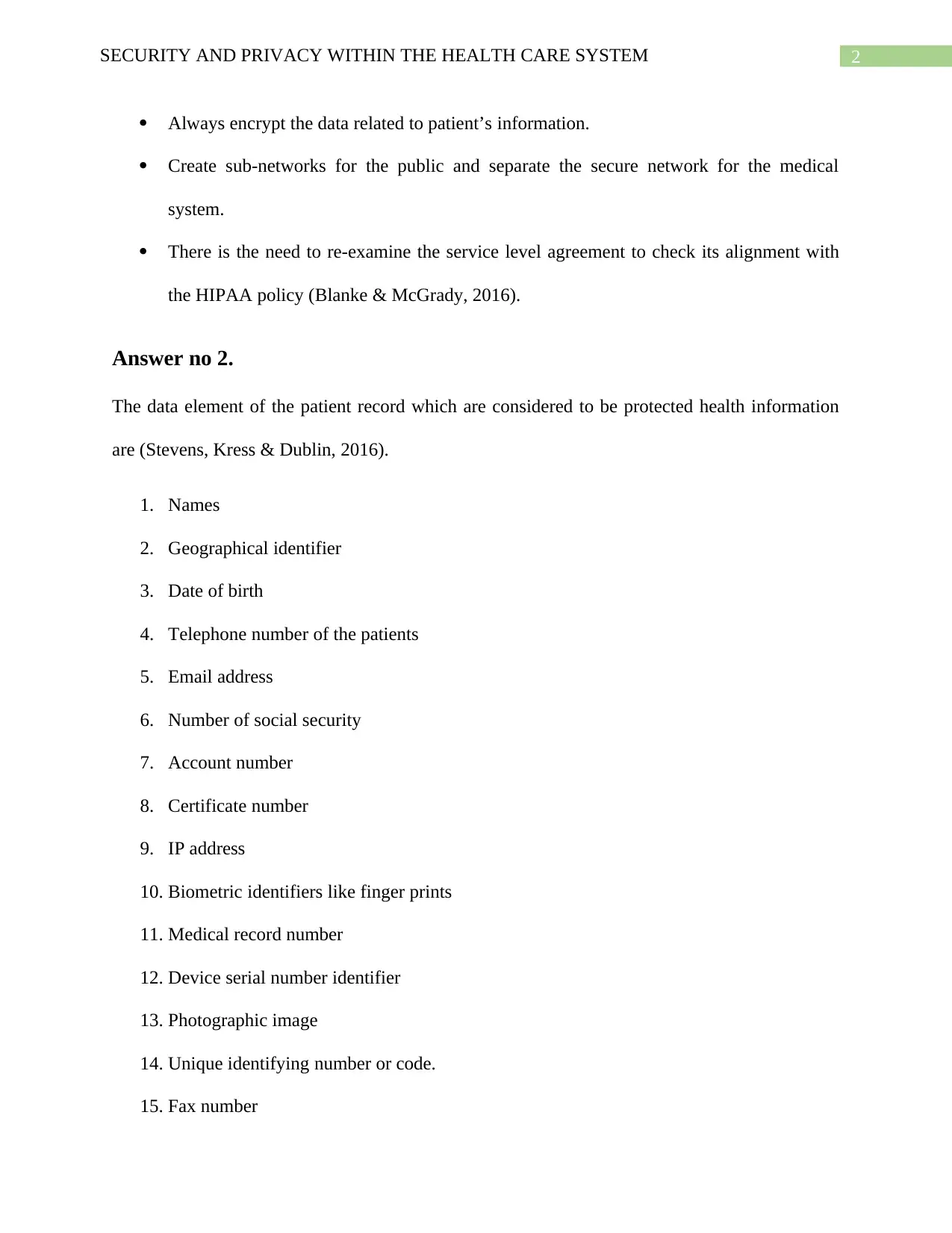
2SECURITY AND PRIVACY WITHIN THE HEALTH CARE SYSTEM
Always encrypt the data related to patient’s information.
Create sub-networks for the public and separate the secure network for the medical
system.
There is the need to re-examine the service level agreement to check its alignment with
the HIPAA policy (Blanke & McGrady, 2016).
Answer no 2.
The data element of the patient record which are considered to be protected health information
are (Stevens, Kress & Dublin, 2016).
1. Names
2. Geographical identifier
3. Date of birth
4. Telephone number of the patients
5. Email address
6. Number of social security
7. Account number
8. Certificate number
9. IP address
10. Biometric identifiers like finger prints
11. Medical record number
12. Device serial number identifier
13. Photographic image
14. Unique identifying number or code.
15. Fax number
Always encrypt the data related to patient’s information.
Create sub-networks for the public and separate the secure network for the medical
system.
There is the need to re-examine the service level agreement to check its alignment with
the HIPAA policy (Blanke & McGrady, 2016).
Answer no 2.
The data element of the patient record which are considered to be protected health information
are (Stevens, Kress & Dublin, 2016).
1. Names
2. Geographical identifier
3. Date of birth
4. Telephone number of the patients
5. Email address
6. Number of social security
7. Account number
8. Certificate number
9. IP address
10. Biometric identifiers like finger prints
11. Medical record number
12. Device serial number identifier
13. Photographic image
14. Unique identifying number or code.
15. Fax number
⊘ This is a preview!⊘
Do you want full access?
Subscribe today to unlock all pages.

Trusted by 1+ million students worldwide
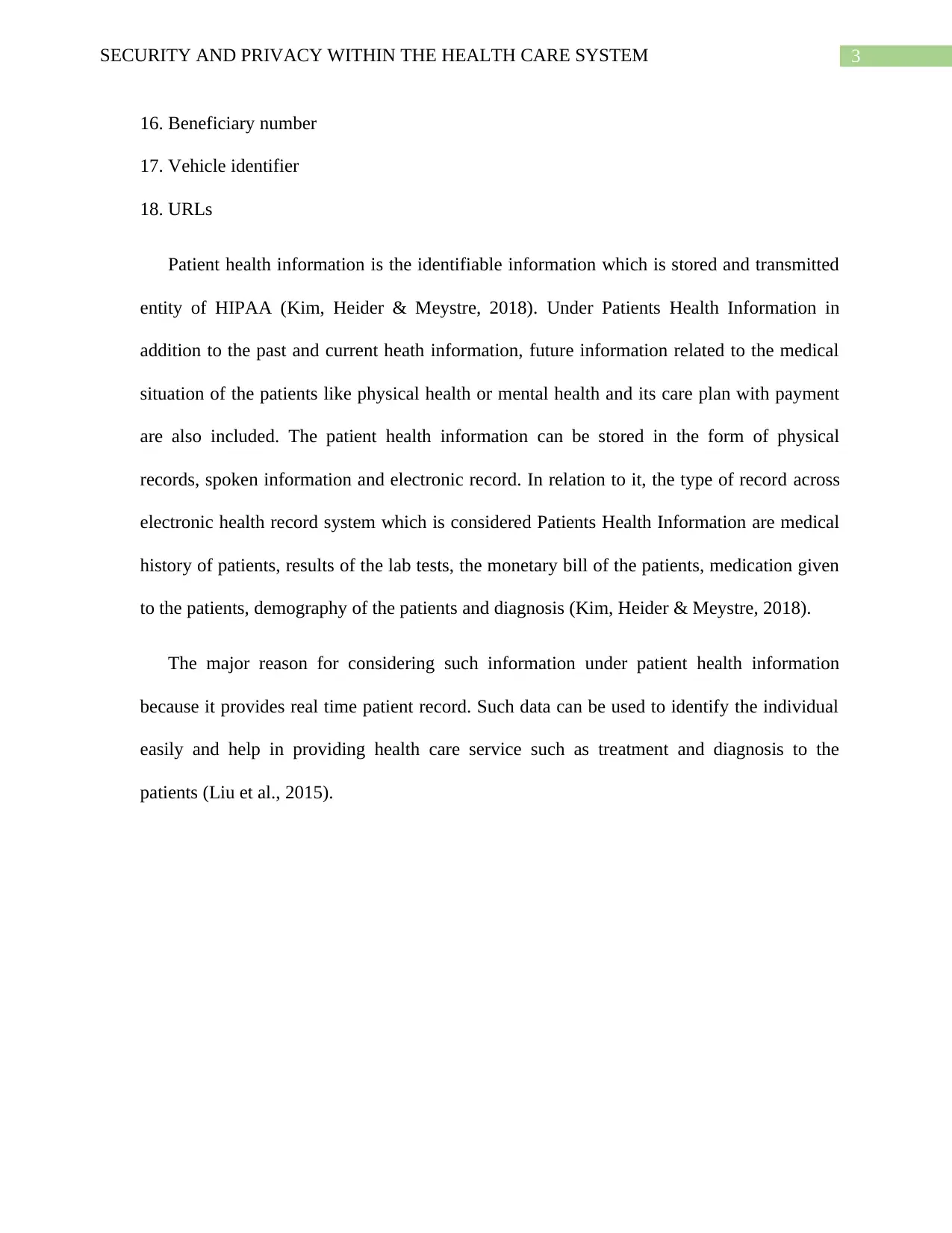
3SECURITY AND PRIVACY WITHIN THE HEALTH CARE SYSTEM
16. Beneficiary number
17. Vehicle identifier
18. URLs
Patient health information is the identifiable information which is stored and transmitted
entity of HIPAA (Kim, Heider & Meystre, 2018). Under Patients Health Information in
addition to the past and current heath information, future information related to the medical
situation of the patients like physical health or mental health and its care plan with payment
are also included. The patient health information can be stored in the form of physical
records, spoken information and electronic record. In relation to it, the type of record across
electronic health record system which is considered Patients Health Information are medical
history of patients, results of the lab tests, the monetary bill of the patients, medication given
to the patients, demography of the patients and diagnosis (Kim, Heider & Meystre, 2018).
The major reason for considering such information under patient health information
because it provides real time patient record. Such data can be used to identify the individual
easily and help in providing health care service such as treatment and diagnosis to the
patients (Liu et al., 2015).
16. Beneficiary number
17. Vehicle identifier
18. URLs
Patient health information is the identifiable information which is stored and transmitted
entity of HIPAA (Kim, Heider & Meystre, 2018). Under Patients Health Information in
addition to the past and current heath information, future information related to the medical
situation of the patients like physical health or mental health and its care plan with payment
are also included. The patient health information can be stored in the form of physical
records, spoken information and electronic record. In relation to it, the type of record across
electronic health record system which is considered Patients Health Information are medical
history of patients, results of the lab tests, the monetary bill of the patients, medication given
to the patients, demography of the patients and diagnosis (Kim, Heider & Meystre, 2018).
The major reason for considering such information under patient health information
because it provides real time patient record. Such data can be used to identify the individual
easily and help in providing health care service such as treatment and diagnosis to the
patients (Liu et al., 2015).
Paraphrase This Document
Need a fresh take? Get an instant paraphrase of this document with our AI Paraphraser
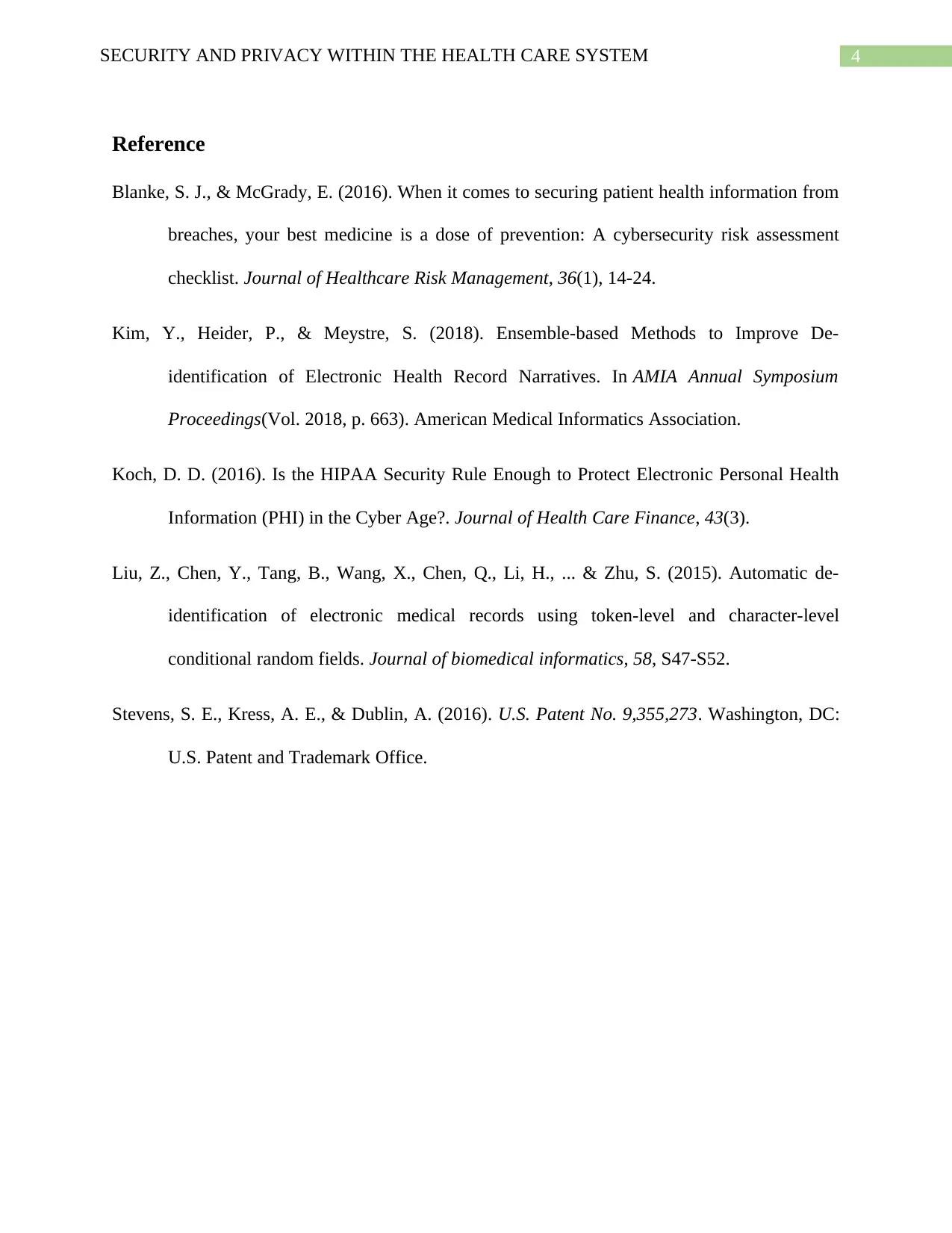
4SECURITY AND PRIVACY WITHIN THE HEALTH CARE SYSTEM
Reference
Blanke, S. J., & McGrady, E. (2016). When it comes to securing patient health information from
breaches, your best medicine is a dose of prevention: A cybersecurity risk assessment
checklist. Journal of Healthcare Risk Management, 36(1), 14-24.
Kim, Y., Heider, P., & Meystre, S. (2018). Ensemble-based Methods to Improve De-
identification of Electronic Health Record Narratives. In AMIA Annual Symposium
Proceedings(Vol. 2018, p. 663). American Medical Informatics Association.
Koch, D. D. (2016). Is the HIPAA Security Rule Enough to Protect Electronic Personal Health
Information (PHI) in the Cyber Age?. Journal of Health Care Finance, 43(3).
Liu, Z., Chen, Y., Tang, B., Wang, X., Chen, Q., Li, H., ... & Zhu, S. (2015). Automatic de-
identification of electronic medical records using token-level and character-level
conditional random fields. Journal of biomedical informatics, 58, S47-S52.
Stevens, S. E., Kress, A. E., & Dublin, A. (2016). U.S. Patent No. 9,355,273. Washington, DC:
U.S. Patent and Trademark Office.
Reference
Blanke, S. J., & McGrady, E. (2016). When it comes to securing patient health information from
breaches, your best medicine is a dose of prevention: A cybersecurity risk assessment
checklist. Journal of Healthcare Risk Management, 36(1), 14-24.
Kim, Y., Heider, P., & Meystre, S. (2018). Ensemble-based Methods to Improve De-
identification of Electronic Health Record Narratives. In AMIA Annual Symposium
Proceedings(Vol. 2018, p. 663). American Medical Informatics Association.
Koch, D. D. (2016). Is the HIPAA Security Rule Enough to Protect Electronic Personal Health
Information (PHI) in the Cyber Age?. Journal of Health Care Finance, 43(3).
Liu, Z., Chen, Y., Tang, B., Wang, X., Chen, Q., Li, H., ... & Zhu, S. (2015). Automatic de-
identification of electronic medical records using token-level and character-level
conditional random fields. Journal of biomedical informatics, 58, S47-S52.
Stevens, S. E., Kress, A. E., & Dublin, A. (2016). U.S. Patent No. 9,355,273. Washington, DC:
U.S. Patent and Trademark Office.
1 out of 5
Related Documents
Your All-in-One AI-Powered Toolkit for Academic Success.
+13062052269
info@desklib.com
Available 24*7 on WhatsApp / Email
![[object Object]](/_next/static/media/star-bottom.7253800d.svg)
Unlock your academic potential
Copyright © 2020–2025 A2Z Services. All Rights Reserved. Developed and managed by ZUCOL.





